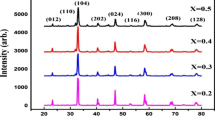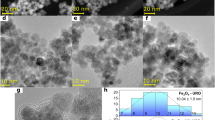Abstract
Hyperthermia treatment of different cancers based on magnetic nanoparticles has gained significant attention in recent years. In this work, biocompatible maghemite (γ-Fe2O3) nanorods were synthesized by dehydroxylation of lepidocrocite (γ-FeOOH) nanorods, using hydrolysis of ferrous salts in the presence of urea followed by calcination at 300 °C for 3 h. Maghemite nanospheres were also synthesized by oxidation of co-precipitated magnetite (Fe3O4) nanoparticles, followed by heat treatment at 250 °C for 3 h. The samples were analyzed by X-ray diffraction, vibrating sample magnetometry, and field emission scanning electron microscopy techniques. Cell viability of nanorods and nanospheres before and after applying a magnetic field was studied by MTT assay on G292 cell lines as a candidate of osteosarcoma 2D-cultured model. The heating capacity of the rod-like and spherical magnetic nanoparticles (MNP) was evaluated under a magnetic field using a solid state induction heating equipment. Moreover, the minimal inhibitory concentration (MIC) antibacterial activity of magnetic nanorods and nanospheres was investigated. The results showed that cell proliferation gradually increased in the presence of both maghemite nanorods and nanospheres compared to the control sample. However, cell viability decreased after applying hyperthermia treatment as indicative of cell apoptosis. Quantification of antibacterial properties also showed the MIC behavior of both nanoparticles at a concentration of 0.078 mg/ml.












Similar content being viewed by others
References
Kundu, B., Ghosh, D., Sinha, M. K., Sen, P. S., Balla, V. K., Das, N., & Basu, D. (2013). Doxorubicin-intercalated nano-hydroxyapatite drug-delivery system for liver cancer: an animal model. Ceramics International, 39(8), 9557–9566.
Ye, Y., & Geng, B. (2012). Magnetic nanotubes: synthesis, properties, and applications. Critical Reviews in Solid State and Materials Sciences, 37(2), 75–93.
Yigit, M. V., Moore, A., & Medarova, Z. (2012). Magnetic nanoparticles for cancer diagnosis and therapy. Pharmaceutical Research, 29(5), 1180–1188.
Stanciu, L., Won, Y. H., Ganesana, M., & Andreescu, S. (2009). Magnetic particle-based hybrid platforms for bioanalytical sensors. Sensors, 9(4), 2976–2999.
Harifi, T., & Montazer, M. (2014). In situ synthesis of iron oxide nanoparticles on polyester fabric utilizing color, magnetic, antibacterial and sono-Fenton catalytic properties. Journal of Materials Chemistry B, 2(3), 272–282.
Heidari, F., Bahrololoom, M. E., Vashaee, D., & Tayebi, L. (2015). In situ preparation of iron oxide nanoparticles in natural hydroxyapatite/chitosan matrix for bone tissue engineering application. Ceramics International, 41(2), 3094–3100.
Trahms, L. (2015). Magnetic nanoparticles for biomedical applications. Biomedical Engineering/Biomedizinische Technik, 60(5), 389–391.
Bañobre-López, M., Teijeiro, A., & Rivas, J. (2013). Magnetic nanoparticle-based hyperthermia for cancer treatment. Reports of Practical Oncology & Radiotherapy, 18(6), 397–400.
World health organization 2015, Fact sheet N°297 Updated February.
Abenojar, E.C., Wickramasinghe, S., Bas-Concepcion, J. and Samia, A.C.S., 2016. Structural effects on the magnetic hyperthermia properties of iron oxide nanoparticles. Progress in Natural Science: Materials International.
Martın, J. I., Nogues, J., Liu, K., Vicent, J. L., & Schuller, I. K. (2003). Ordered magnetic nanostructures: fabrication and properties. Journal of Magnetism and Magnetic Materials, 256(1), 449–501.
Chang, J., Ma, Q., Ma, J. and Ma, H., 2016. Synthesis of Fe3O4 nanowire@ CeO 2/Ag nanocomposites with enhanced photocatalytic activity under sunlight exposure. Ceramics International.
Woo, K., Lee, H. J., Ahn, J. P., & Park, Y. S. (2003). Sol–gel mediated synthesis of Fe2O3 nanorods. Advanced Materials, 15(20), 1761–1764.
Zhong, L. S., Hu, J. S., Liang, H. P., Cao, A. M., Song, W. G., & Wan, L. J. (2006). Self-assembled 3D flowerlike iron oxide nanostructures and their application in water treatment. Advanced Materials, 18(18), 2426–2431.
Rashid, N. M., Li, X., Kishi, N., & Soga, T. (2014). Synthesis of iron oxide nanoflakes at lower temperature by air oxidation of iron foils. Japanese Journal of Applied Physics, 53(11S), 11RE04.
Mohapatra, J., Mitra, A., Tyagi, H., Bahadur, D., & Aslam, M. (2015). Iron oxide nanorods as high-performance magnetic resonance imaging contrast agents. Nanoscale, 7(20), 9174–9184.
Geng, Y. A. N., Dalhaimer, P., Cai, S., Tsai, R., Tewari, M., Minko, T., & Discher, D. E. (2007). Shape effects of filaments versus spherical particles in flow and drug delivery. Nature Nanotechnology, 2(4), 249–255.
Rebolledo, A. F., Bomatí-Miguel, O., Marco, J. F., & Tartaj, P. (2008). A facile synthetic route for the preparation of superparamagnetic iron oxide nanorods and nanorices with tunable surface functionality. Advanced Materials, 20(9), 1760–1765.
Gil, S., Correia, C. R., & Mano, J. F. (2015). Magnetically labeled cells with surface-modified Fe3O4 spherical and rod-shaped magnetic nanoparticles for tissue engineering applications. Advanced Healthcare Materials, 4(6), 883–891.
Ericsson, H.M. and Sherris, J.C., 1971. Antibiotic sensitivity testing. Report of an international collaborative study. Acta Pathologica et Microbiologica Scandinavica, (Suppl. 217).
Kim, W., Suh, C. Y., Cho, S. W., Roh, K. M., Kwon, H., Song, K., & Shon, I. J. (2012). A new method for the identification and quantification of magnetite–maghemite mixture using conventional X-ray diffraction technique. Talanta, 94, 348–352.
Nasrazadani, S., & Raman, A. (1993). The application of infrared spectroscopy to the study of rust systems—II. Study of cation deficiency in magnetite (Fe 3 O 4) produced during its transformation to maghemite (γ-Fe 2 O 3) and hematite (α-Fe 2 O 3). Corrosion Science, 34(8), 1355–1365.
Yousefi, T., Davarkhah, R., Golikand, A. N., Mashhadizadeh, M. H., & Abhari, A. (2013). Facile cathodicelectrosynthesis and characterization of iron oxide nano-particles. Progress in Natural Science: Materials International, 23(1), 51–54.
Ercuta, A., & Chirita, M. (2013). Highly crystalline porous magnetite and vacancy-ordered maghemite microcrystals of rhombohedral habit. Journal of Crystal Growth, 380, 182–186.
Chen, R., Zhao, S., Liu, H., Song, X., & Wei, Y. (2015). Preparation and photocatalytic activity of lepidocrocites obtained by photocatalytic oxidation of Fe (II) in the presence of citric acid. Journal of Photochemistry and Photobiology A: Chemistry, 312, 73–80.
Cudennec, Y., & Lecerf, A. (2005). Topotactic transformations of goethite and lepidocrocite into hematite and maghemite. Solid State Sciences, 7(5), 520–529.
Goss, C. J. (1988). Saturation magnetisation, coercivity and lattice parameter changes in the system Fe3O4-γFe2O3, and their relationship to structure. Physics and Chemistry of Minerals, 16(2), 164–171.
Cornell, R. M., & Schwertmann, U. (2003). The iron oxides: structure, properties, reactions, occurrences and uses. Hoboken: Wiley.
Krahne, R., Manna, L., Morello, G., Figuerola, A., George, C., & Deka, S. (2013). Physical properties of nanorods (p. 217). Berlin: Springer.
Baaziz, W., Pichon, B., Fleutot, S., Liu, Y., Lefevre, C., Greneche, J., Toumi, M., Mhiri, T., & Begin-Colin, S. (2014). Magnetic iron oxide nanoparticles: reproducible tuning of the size and nanosized-dependent composition, defects, and spin canting. Journal of Physical Chemistry C, 118(7), 3795–3810.
Varadan, V. K., Chen, L., & **e, J. (2008). Nanomedicine: design and applications of magnetic nanomaterials, nanosensors and nanosystems. Hoboken: Wiley.
Narlikar, A. V., & Fu, Y. Y. (2010). Oxford handbook of nanoscience and technology: volume 3: Applications (Vol. 3). Oxford: Oxford University Press.
Pearce, J., Giustini, A., Stigliano, R., & Hoopes, P. J. (2013). Magnetic heating of nanoparticles: the importance of particle clustering to achieve therapeutic temperatures. Journal of Nanotechnology in Engineering and Medicine, 4(1), 011005.
Suto, M., Hirota, Y., Mamiya, H., Fujita, A., Kasuya, R., Tohji, K., & Jeyadevan, B. (2009). Heat dissipation mechanism of magnetite nanoparticles in magnetic fluid hyperthermia. Journal of Magnetism and Magnetic Materials, 321(10), 1493–1496.
Chen, L., Mccrate, J., Lee, J., & Li, H. (2011). The role of surface charge on the uptake and biocompatibility of hydroxyapatite nanoparticles with osteoblast cells. Nanotechnology, 22(10), 105708.
Hou, C., Lin, F., Hou, S., & Liu, J. (2014). Hyperthermia induces apoptosis through endoplasmic reticulum and reactive oxygen species in human osteosarcoma cells. IJMS, 15(10), 17380–17395.
Asín, L., Ibarra, M., Tres, A., & Goya, G. (2012). Controlled cell death by magnetic hyperthermia: effects of exposure time, field amplitude, and nanoparticle concentration. Pharmaceutical Research, 29(5), 1319–1327.
He, Y., Ingudam, S., Reed, S., Gehring, A., Strobaugh, T., & Irwin, P. (2016). Study on the mechanism of antibacterial action of magnesium oxide nanoparticles against foodborne pathogens. Journal of Nanobiotechnology, 14(1).
Ravishankar Rai, V. and Jamuna Bai, A., 2011. Nanoparticles and their potential application as antimicrobials. Science against microbial pathogens, communicating current research and technological advances. Formatex, Badajoz, pp. 197–209.
Bhattacharyya, A., Chattopadhyay, R., Mitra, S., & Crowe, S. E. (2014). Oxidative stress: an essential factor in the pathogenesis of gastrointestinal mucosal diseases. Physiological Reviews, 94(2), 329–354.
Author information
Authors and Affiliations
Corresponding author
Rights and permissions
About this article
Cite this article
Yousefi, A., Seyyed Ebrahimi, S., Seyfoori, A. et al. Maghemite Nanorods and Nanospheres: Synthesis and Comparative Physical and Biological Properties. BioNanoSci. 8, 95–104 (2018). https://doi.org/10.1007/s12668-017-0431-1
Published:
Issue Date:
DOI: https://doi.org/10.1007/s12668-017-0431-1




